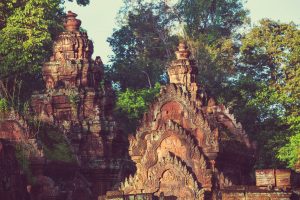Officials in New York have returned another 30 Khmer cultural artifacts to Cambodia, years after they were looted from the country and illegally sold on the international art market. On Monday, the U.S. Attorney’s Office for the Southern District of New York hosted a repatriation ceremony for the works – the latest artifacts to be recovered as a result of an ongoing U.S. investigation into the activities of the late British antiquities trader Douglas Latchford.
“These statues and artifacts, which range in age from the Bronze Age to the 12th century, are of extraordinary cultural value to the Cambodian people and we are delighted to be sending them home today,” prosecutor Damian Williams said during a press conference.
The artifacts include a 10th-century sandstone sculpture depicting the Hindu war deity Skanda, and a three-ton sculpture of the Hindu elephant god Ganesha that was listed on the “Ten Most Wanted Antiquities” list maintained by the Antiquities Coalition, a Washington, D.C.-based organization working to stop the looting and trafficking of cultural heritage. (The Ganesha statue was previously in the private collection of the U.S. tech billionaire James H. Clark, who handed it over to the U.S. government after its provenance was made known.) Both were stolen from the ancient Khmer capital Koh Ker, in Preah Vihear province, during the turmoil of the Cambodian civil war in the 1990s.
Upon their return to Cambodia, the antiquities will be displayed at the National Museum of Cambodia in Phnom Penh, Ambassador Keo Chhea told Reuters after attending Monday’s ceremony.
In a statement, the U.S. Department of Justice stated that the 30 works “were stolen from Cambodia as part of an organized looting network” and subsequently sold by antiquities dealer Douglas Latchford. Feted by the Cambodian government and treated for years as a respected scholar and collector of Southeast Asian antiquities, the British collector was dogged during his final years by credible accusations that he acquired treasures he knew to have been stolen from remote Cambodian temples, fattening his own collection and profiting by smoothing their entry into private collections.
Prior to his death in August 2020, U.S. prosecutors indicted Latchford for illicitly trafficking in ancient Khmer artifacts, claiming that he had “built a career out of the smuggling and illicit sale of priceless Cambodian antiquities, often straight from archaeological sites.” With the assistance of Cambodian officials and his daughter Nawapan Kriangsak, who after his death pledged to return Latchford’s collection of Khmer artifacts to Cambodia, U.S. officials have since sought to recover the works as a means of “redressing the wrongs committed by Latchford and other looters who would exploit and profit from the pain and disruption of war.”
In a statement in January of this year, Ricky J. Patel, a special agent in the U.S. Department of Homeland Security, wrote that Latchford had run an “illegitimate enterprise by smuggling looted antiquities into the United States with blatant disregard for U.S. Customs laws.” Latchford facilitated the thefts by “falsifying customs documentation and providing deceptive paperwork to collectors for sale on the international art market.” Latchford denied any involvement with looted antiquities.
The return marks the latest in a painstakingly incremental process of repatriating the priceless cultural heritage that was looted and sold on the international art market during Cambodia’s decades of civil war. In 2014, U.S. federal prosecutors returned the Duryodhana, a looted 10th-century sandstone sculpture that was stolen from Cambodia in 1972 and sold at an auction in London three years later. Another 27 looted antiquities were returned last year.
At a time of considerable friction in U.S.-Cambodia relations, the cooperation of American officials in helping retrieve the country’s diaspora of looted antiquities remains a rare area of concord.

































